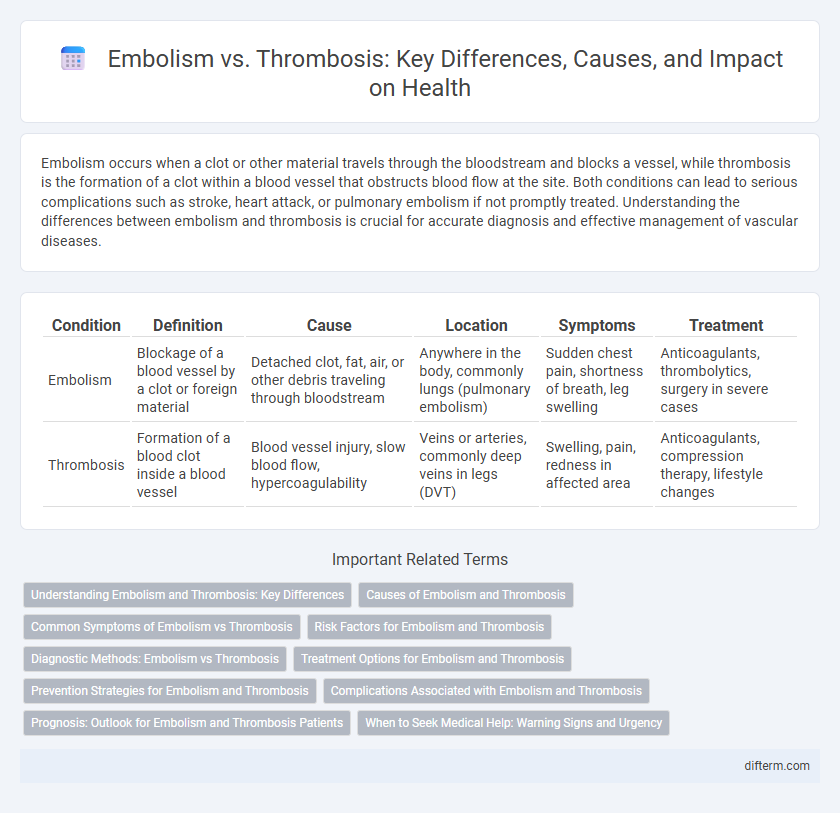Embolism occurs when a clot or other material travels through the bloodstream and blocks a vessel, while thrombosis is the formation of a clot within a blood vessel that obstructs blood flow at the site. Both conditions can lead to serious complications such as stroke, heart attack, or pulmonary embolism if not promptly treated. Understanding the differences between embolism and thrombosis is crucial for accurate diagnosis and effective management of vascular diseases.
Table of Comparison
| Condition | Definition | Cause | Location | Symptoms | Treatment |
|---|---|---|---|---|---|
| Embolism | Blockage of a blood vessel by a clot or foreign material | Detached clot, fat, air, or other debris traveling through bloodstream | Anywhere in the body, commonly lungs (pulmonary embolism) | Sudden chest pain, shortness of breath, leg swelling | Anticoagulants, thrombolytics, surgery in severe cases |
| Thrombosis | Formation of a blood clot inside a blood vessel | Blood vessel injury, slow blood flow, hypercoagulability | Veins or arteries, commonly deep veins in legs (DVT) | Swelling, pain, redness in affected area | Anticoagulants, compression therapy, lifestyle changes |
Understanding Embolism and Thrombosis: Key Differences
Embolism involves the sudden obstruction of a blood vessel by a traveling clot or foreign material, while thrombosis is the formation of a stationary blood clot within a vessel. Thrombosis typically occurs in veins or arteries, leading to localized blockage, whereas embolism can cause blockages in distant organs like the lungs (pulmonary embolism) or brain (stroke). Understanding these differences is crucial for diagnosing and treating vascular conditions effectively.
Causes of Embolism and Thrombosis
Embolism occurs when a blood clot, fat globule, air bubble, or other material travels through the bloodstream and blocks a vessel, often caused by deep vein thrombosis or arterial plaque rupture. Thrombosis involves the formation of a stationary blood clot within a blood vessel, primarily triggered by endothelial injury, blood flow stasis, or hypercoagulability conditions such as atrial fibrillation or genetic clotting disorders. Both embolism and thrombosis share risk factors like immobility, surgery, cancer, and smoking, which contribute to abnormal clot formation or dislodgement.
Common Symptoms of Embolism vs Thrombosis
Embolism commonly presents with sudden onset of sharp pain, shortness of breath, and rapid heart rate, often affecting the lungs or brain due to blockage of blood flow. Thrombosis symptoms typically include localized swelling, warmth, redness, and tenderness, frequently occurring in the deep veins of the legs. Recognizing these distinct symptom patterns is crucial for timely diagnosis and treatment of both embolism and thrombosis.
Risk Factors for Embolism and Thrombosis
Risk factors for embolism include atrial fibrillation, recent surgery, and immobilization, which promote clot formation and subsequent embolization. Thrombosis risk factors involve endothelial injury, hypercoagulability, and venous stasis, often linked to trauma, cancer, pregnancy, and inherited clotting disorders. Identifying these risk factors is critical for prevention and targeted treatment strategies in cardiovascular and venous diseases.
Diagnostic Methods: Embolism vs Thrombosis
Diagnostic methods for embolism primarily include computed tomography pulmonary angiography (CTPA) and ventilation-perfusion (V/Q) scans to detect obstructions in blood vessels. Thrombosis diagnosis relies heavily on Doppler ultrasound imaging for vein visualization and D-dimer blood tests to identify clot formation. Both conditions may require magnetic resonance imaging (MRI) or venography to assess clot location and severity accurately.
Treatment Options for Embolism and Thrombosis
Treatment options for embolism primarily include anticoagulants such as heparin and warfarin to prevent further clot formation, along with thrombolytic therapy in acute cases to dissolve existing emboli. Thrombosis management often involves anticoagulant medications, mechanical thrombectomy in severe instances, and lifestyle modifications to reduce risk factors like smoking and obesity. Both conditions may require long-term therapy and monitoring to prevent recurrence and complications such as stroke or pulmonary embolism.
Prevention Strategies for Embolism and Thrombosis
Prevention strategies for embolism and thrombosis prioritize early mobilization, anticoagulant therapy, and lifestyle modifications such as smoking cessation and regular exercise. Compression stockings and hydration are effective in reducing venous stasis, which lowers the risk of deep vein thrombosis and subsequent embolism. Routine monitoring and patient education on recognizing symptoms also play a critical role in preventing complications associated with these vascular conditions.
Complications Associated with Embolism and Thrombosis
Embolism and thrombosis can lead to severe complications such as pulmonary embolism, stroke, and myocardial infarction due to disrupted blood flow. Thrombosis often results in localized tissue damage from ischemia, while embolism causes systemic blockages that can impair critical organs rapidly. Early diagnosis and treatment are crucial to prevent long-term morbidity and mortality associated with these conditions.
Prognosis: Outlook for Embolism and Thrombosis Patients
Prognosis for embolism patients varies significantly depending on the embolus location and timely intervention; pulmonary embolism has a higher risk of mortality if untreated, whereas cerebral embolism requires urgent care to prevent severe neurological damage. Thrombosis prognosis depends on the thrombus size, location, and anticoagulation effectiveness, with deep vein thrombosis often responding well to early treatment but posing risks for post-thrombotic syndrome. Both conditions demand prompt diagnosis and management to improve patient outcomes and reduce complications such as organ damage or recurrent vascular events.
When to Seek Medical Help: Warning Signs and Urgency
Sudden chest pain, shortness of breath, or pronounced swelling in limbs are critical signs of embolism or thrombosis requiring immediate medical attention. Rapid onset of symptoms such as severe headache, vision changes, or difficulty speaking also signals urgent intervention. Timely diagnosis and treatment significantly reduce the risk of complications like stroke or pulmonary embolism.
Embolism vs Thrombosis Infographic

 difterm.com
difterm.com